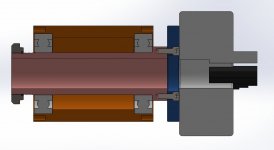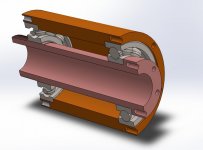Generic Default
Aluminum
- Joined
- Jan 23, 2016
- Location
- Wilmington / Long Beach
Hi everyone, first post but I've been creepin' anonymously here for the last 5 years or so.
I'm making a relatively small machine with a sliding headstock and a subspindle. They're nearly identical. I've read as many technical references and forum threads on machine spindles as I can but the spindles are by far the most difficult part of the machine to make correctly. I'll link to some of the sources below.
http://www.practicalmachinist.com/vb/general/lathe-spindle-bearings-design-163580/
http://www.practicalmachinist.com/vb/general-archive/bearings-making-mini-lathe-spindle-80970/
http://www.practicalmachinist.com/vb/general/lathe-spindle-type-grade-steel-167191/
and also;
System rigidity


Pink = Inner Spindle Tube
Orange = Outer Bearing Housing
Blue = Face Plate
Anyway, my current design has the machine's main spindles at a 1.25" bore, fitting in 45mm (1.77") angular contact bearings spaced about 4 inches center-to-center. The spindle tube wall thickness is just about 0.25". Overall spindle length is 6.5 inches with a 2.25" face plate flange on the business end and 1.77-18 threads on the other end to preload the bearings with a bearing nut/disc spring washer and hold the drive pulley/gear on the back. The flanged end has 6 1/4-20 tapped holes so the faceplate can be bolted to it later, then a 5 inch chuck or ER40 collet nose will be bolted and centered on that face plate.
That's the inside spindle tube, the part that must spin precisely up to around 4,000 RPM and take all of the turning/milling forces. The OD of the angular contact bearings will be seated in a single aluminum tube (4 inch OD, 3 inch ID) with bored bearing journals. Thermal expansion fit on the 7209 bearings, 85mm OD.
My main concerns are are concentricity and roundness of the bearing surfaces. My plan is to turn the parts in a single chucking operation on a CNC tool room lathe with an 8 station turret. The outer aluminum housing tubes will be chucked, OD turned and faced, then a big boring bar will make the ID bearing journals with a grooving tool. Part off after that.
I don't have access to a cylindrical grinder and I'm not willing to pay $~1,000 to grind and heat treat the inner spindles. I don't need something accurate to a micron, my goal with this machine is to be able to hold overall part tolerances to just under 0.001" during turning operations. With ABEC-3 angular contact bearings, eccentricity is <0.0002". So as long as the spindle tube bearing surfaces are concentric, total spindle runout should be in the range of 0.0005" wobble per 4 inches (or less).
The outer tube housing will be 6061 aluminum. The inner steel tube, I'm not 100% sure about.
I'm leaning toward 4142 pre-hard turned from 2.25 round bar. Other options are 1144 stress-proof from the same size, or starting with 2.25 A513 DOM steel tubing to avoid drilling through with a big drill.
4142 = 90,000 PSI yield
1144 = 100,000 PSI yield
A513 = 70,000 PSI yield
The spindle is fairly short and will not be used for hogging inconel or anything with huge loads, but I don't want it to bend or break over time from fatigue, especially around the flange neck area.
Does anyone have advice for me? I know some of you are experts on spindles. Is my plan decent or will it be a complete fail?
Thanks!
I'm making a relatively small machine with a sliding headstock and a subspindle. They're nearly identical. I've read as many technical references and forum threads on machine spindles as I can but the spindles are by far the most difficult part of the machine to make correctly. I'll link to some of the sources below.
http://www.practicalmachinist.com/vb/general/lathe-spindle-bearings-design-163580/
http://www.practicalmachinist.com/vb/general-archive/bearings-making-mini-lathe-spindle-80970/
http://www.practicalmachinist.com/vb/general/lathe-spindle-type-grade-steel-167191/
and also;
System rigidity


Pink = Inner Spindle Tube
Orange = Outer Bearing Housing
Blue = Face Plate
Anyway, my current design has the machine's main spindles at a 1.25" bore, fitting in 45mm (1.77") angular contact bearings spaced about 4 inches center-to-center. The spindle tube wall thickness is just about 0.25". Overall spindle length is 6.5 inches with a 2.25" face plate flange on the business end and 1.77-18 threads on the other end to preload the bearings with a bearing nut/disc spring washer and hold the drive pulley/gear on the back. The flanged end has 6 1/4-20 tapped holes so the faceplate can be bolted to it later, then a 5 inch chuck or ER40 collet nose will be bolted and centered on that face plate.
That's the inside spindle tube, the part that must spin precisely up to around 4,000 RPM and take all of the turning/milling forces. The OD of the angular contact bearings will be seated in a single aluminum tube (4 inch OD, 3 inch ID) with bored bearing journals. Thermal expansion fit on the 7209 bearings, 85mm OD.
My main concerns are are concentricity and roundness of the bearing surfaces. My plan is to turn the parts in a single chucking operation on a CNC tool room lathe with an 8 station turret. The outer aluminum housing tubes will be chucked, OD turned and faced, then a big boring bar will make the ID bearing journals with a grooving tool. Part off after that.
I don't have access to a cylindrical grinder and I'm not willing to pay $~1,000 to grind and heat treat the inner spindles. I don't need something accurate to a micron, my goal with this machine is to be able to hold overall part tolerances to just under 0.001" during turning operations. With ABEC-3 angular contact bearings, eccentricity is <0.0002". So as long as the spindle tube bearing surfaces are concentric, total spindle runout should be in the range of 0.0005" wobble per 4 inches (or less).
The outer tube housing will be 6061 aluminum. The inner steel tube, I'm not 100% sure about.
I'm leaning toward 4142 pre-hard turned from 2.25 round bar. Other options are 1144 stress-proof from the same size, or starting with 2.25 A513 DOM steel tubing to avoid drilling through with a big drill.
4142 = 90,000 PSI yield
1144 = 100,000 PSI yield
A513 = 70,000 PSI yield
The spindle is fairly short and will not be used for hogging inconel or anything with huge loads, but I don't want it to bend or break over time from fatigue, especially around the flange neck area.
Does anyone have advice for me? I know some of you are experts on spindles. Is my plan decent or will it be a complete fail?
Thanks!



